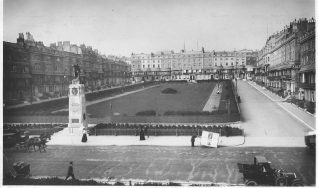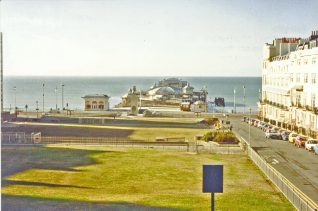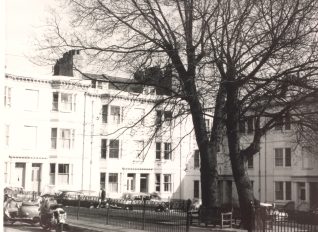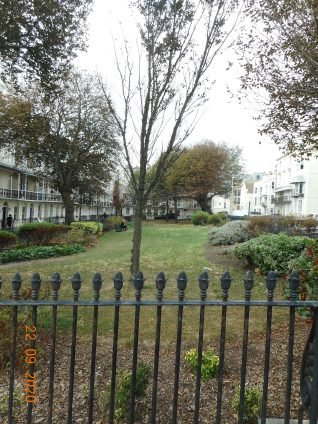Garden Squares: Clarence, Regency and Russell







Regency Square and Russell Square are linked by a narrow twitten. Both are Georgian squares, built 200 years ago, each with a large central garden. Immediately to the north of Russell Square, Clarence Square was completed in the 1840s.
At 1.6 acres, Regency Square’s garden is the biggest of the three. An information board in the Regency Square garden includes an 1823 painting of the original garden layout: a large lawn with a path and bedding around the perimeter, the whole enclosed in ornamental railings.
The layout remained largely unchanged for nearly 120 years. Tennis courts were painted on the lawn from 1896. They alternated between the top and bottom ends of the lawn, probably to manage wear and tear on the turf.
Private Enclosures
Brighton has over a dozen such squares and crescents. Most of their central gardens are now public spaces, but all were originally private enclosures that only the residents of each square or crescent was allowed to use. Residents received a key to a garden gate if they paid towards the cost of garden maintenance. Residents’ committees collected the fees and employed gardeners. In 1885, Brighton Corporation compulsorily purchased the central gardens in Bedford Square, Dorset Gardens, Marine Square, New Steine, Norfolk Square, Powis Square, Regency Square, Royal Crescent and Russell Square. But in Clarence, Regency and Russell squares – and probably in others – residents continued to enjoy exclusive use of the gardens in return for funding the garden maintenance.
World War 2
At the outbreak of WW2, the central gardens in many of Brighton’s squares were requisitioned by the War Office. Clarence Square’s garden was requisitioned in spite of it still being privately owned. Railings were removed and the gardens dug up to build air raid shelters. The gardens of Clarence, Regency and Russell squares each had two air raid shelters, each shelter consisting of a brick entrance and a flight of steps leading down to a space containing benches for 100 people. The central gardens in Norfolk Square, Powis Square, Montpelier Crescent and New Steine were also dug up to provide air raid shelters.
Public parks
After the war, the council received government compensation to restore the gardens. Shortages of materials, especially for railings, meant restoration dragged on until well into the 1950s. But it prompted the council to turn the gardens, including Clarence Square, into public spaces. The council took over garden maintenance and the residents’ committees were wound up. This didn’t go down well with everyone. In the 1950s, Regency and Russell square residents repeatedly complained that allowing the public into the gardens was leading to problems with dogs, litter and children playing football and cricket.
In 1967, the Regency Square garden was dug up again, this time to create an underground car park. Lawns were laid out on the car park roof. Trees were planted but failed to establish. The gardens in Clarence and Russell squares were sensitively re-landscaped in 2001, with the post-war ‘hooped’ railings replaced with traditional cast iron railings.
Sources of information
Carder, T. (1990) Encyclopaedia of Brighton, East Sussex County Libraries
East Sussex Record Office at The Keep:
ACC 11314/177
BH/G/2/1759
DB/D 62/11
DB/D/84/5728




No Comments
Add a comment about this page